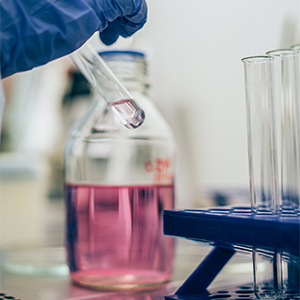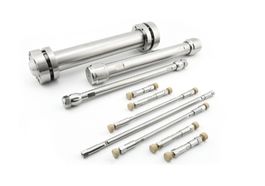Sample pretreatment is the process of sample preparation and extraction, purification and concentration of the components to be measured in the sample. Sample pretreatment aims to eliminate matrix interference, protect the instrument, and improve the assay’s sensitivity, selectivity, accuracy, and precision.
Sample pretreatment method
Sample pretreatment should include all operations before injection except for weighing, dissolving, diluting, etc. The samples need to be.
①filtration.
②extraction.
③ derivatization (pre-column derivatization).
④ liquid chromatography (low-pressure column chromatography).
These operations can be performed manually or automated. The purpose of sample pretreatment is to remove interferents, increase detector sensitivity (enrichment), protect the HPLC column, etc. Sample pretreatment also avoids chromatographic separation failure, in which sample extraction is a key step. It is extremely difficult to extract trace components from many interferents.
Some samples cannot be analyzed by injection after pretreatment and need to be derivatized so that some components without UV absorption or fluorescence can be detected by UV and fluorescence detector after derivatization, which not only improves the sensitivity but also improves the separation (mass change). The sample pretreatment also brings problems, such as sample loss, contamination, incomplete derivatization reflection or multiple reactants generation. Derivatization reactions often affect the accuracy of the test or introduce errors throughout the sample pretreatment process.
Sample solutions for liquid chromatography analysis must be homogeneous and free of particles; the presence of particles can damage the injector and clog the column head. The processed sample should be shaken against the light to check for particles in the sample solution before it is ready to be placed on the column. Whenever particles, turbidity or emulsification are seen, they should be filtered. The filter membrane should be able to retain particles above 0.15 μm. The process of sample filtration may cause the following:
- Contamination of the sample.
- Reduction of the content of the sample components due to adsorption by filtration.
- Errors caused by evaporation of the sample solvent.
The purpose of extraction is to separate the analyzed components from the co-soluble sample medium or to reduce the substances that damage the column (e.g., proteins, etc.) and interfering substances. Organic solvent extraction is generally used, requiring low toxicity of the solvent used for extraction, good volatility, few impurities, good solubility of the sample to be measured and immiscibility with water.
Commonly used are ether, ethyl acetate, dichloromethane, chloroform, benzene or a mixture of two or more solvents. After extraction, the sample can generally be directly injected. Sometimes it needs to be concentrated or blow-dried and concentrated and then dissolved with a fixed volume of liquid or mobile phase into the sample. This increases the concentration of the sample, improves the sensitivity, and simultaneously avoids the interference of the solvent peak on the sample peak. The extraction is to consider the solubility of the sample molecules. In addition to fat-soluble and water-soluble components, there are water-soluble salts made from fat-soluble components, and the extraction methods are as follows:
Water-soluble samples
(1) Acidic components and generated salt extraction method.
Organic solvent extraction of impurities after adjusting to acidic, and then add organic solvent extraction or injection, or blow dry under N2 flow, with appropriate solvent solution and injection.
(2) alkaline components and generated salt extraction method.
Organic solvent extraction of impurities and then adjusted to alkaline, then add organic solvent extraction or into the sample, or blow dry under N2 flow, with the appropriate solvent solution into the sample.
(3) neutral component extraction method.
① organic solvent extraction of impurities, direct analysis by reversed-phase chromatography.
② lipid-soluble components extraction method: organic solvent extraction or injection, or blowing dry under N2 flow, dissolved with the appropriate solvent and then injection.
Contamination in analysis
The environment, containers, and reagents for general testing are all factors that affect the measurement results.
①Environmental contamination of the instrument room with harmful gases, gas solutions, dust, etc., can cause contamination and affect the test results, and this contamination is difficult to correct. Therefore, the instrument room and other laboratories should be isolated and kept clean. The instrument room should be installed with air conditioning, pay attention to moisture, anti-corrosion, and shockproof. The relative humidity of the air should be less than 70 % is appropriate.
②Vessel laboratory commonly used vessels are glass, porcelain, quartz, plastic, etc. The analysis should follow the requirements of the sample to be selected vessels. No matter which vessels are used, a clean container wash strip is very important and guarantees good test results.
③ Reagents in liquid chromatography analysis, the selected reagents must be chromatographic purity, superior purity or analytical purity if, with the content of impurities in the reagents, there will be heterogeneous peaks and affect the determination results.
Configuration of standard solution
In the configuration of standard solutions, the first step is to configure the current concentration of the internal standard solution. In the standard solution and sample solution is best to use the same batch of prepared internal standard solution to reduce errors.
(1) The preparation of standard substances solutions should be chromatographically pure and stable.
(2) Commonly used standard solutions should be stored in low temperatures in brown bottles.
(3) in the preparation of vitamin standards, to be placed in brown volumetric flasks or protected from light to avoid decomposition.
The main failures and solutions in the sample pretreatment process
(1) The appearance of unrelated peaks in the chromatogram may be due to contamination of the sample filter, and the solution is as follows:
① Soak the filter in the sample solvent and test the sample;
② Change the filter type;
③ The use of alternate cleaning techniques.
(2) The peaks of some or all compounds are smaller than expected, especially for low-concentration samples. The reason may be the decrease of adsorption on the surface of the sample filter, and the solutions are as follows.
① Change the type of filter.
② Treating the samples used strictly under the same conditions.
③ Use alternate cleaning techniques.
(3) The recovery is too low or poor. The reason may be that the extraction is not complete. The solution is as follows.
① Increase the extraction time and use hot solvents.
② Modify the cleaning method.
(4) broadening of the peak, and shortening of the column life, the reason may be the interference and pollution brought by the sample, should improve the cleaning method.
(5) Poor precision, the reason may be incomplete recovery. The solution is as follows:
① Improve or replace the derivatization, separation, extraction or other conditions.
②Improve precision with automated processing devices.
Summary
In conclusion, for analytical instruments, the most important practice to avoid failure is correct operation and adjustment, avoiding blind operation, reducing vibration and collision to core parts such as ion chamber, microcurrent amplifier, etc., ensuring insulation, and reducing various system errors to pay attention to the above points, but, also pay attention to daily instrument maintenance, column maintenance, instrument room to keep clean, so that the liquid chromatography in the best In this way, the liquid chromatography can be in the best working condition and play its important role in the analysis.
Post time: Dec-03-2022








